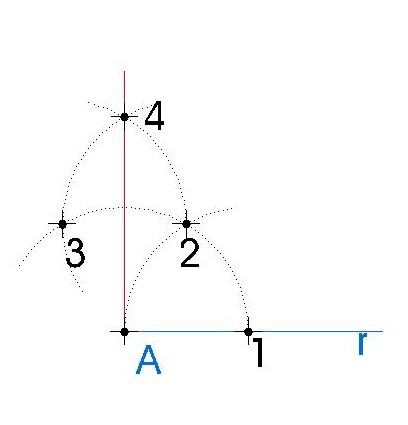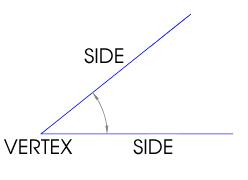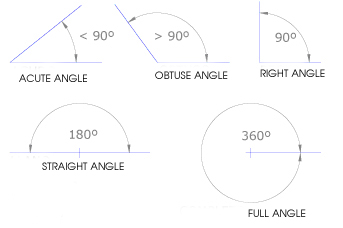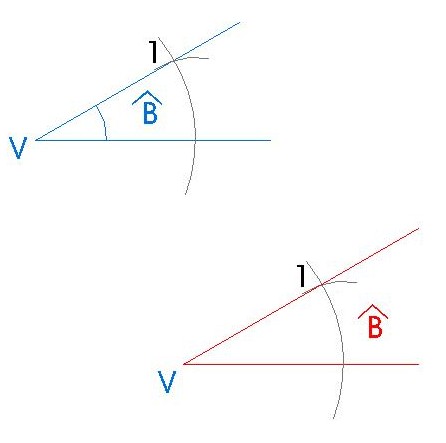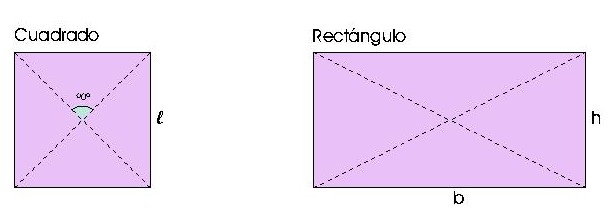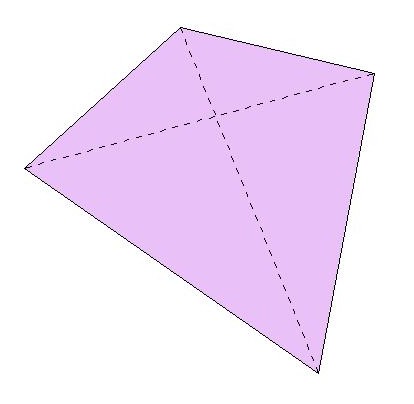Here you are some basic constructions to be made with the compass and the set of triangles.
LINE BISECTOR
The line bisector is a perpendicular line that passes through the midpoint of the segment, so it divides the segment in two equal parts.
STEPS:
First of all we need to draw a segment. We call it AB.
First of all we need to draw a segment. We call it AB.
- Center your compass in point A, open it further from the middle of the segment AB, and draw an arc.
- Do the same from point B, where these arcs cross each other we get points 1 and 2.
- Join 1 and 2, and this way we will get the line bisector of segment AB.
PERPENDICULAR LINE TO A LINE FROM A POINT ON IT
Given a line and a point on that line, we will construct a perpendicular line through the given point.
We say that a line is perpendicular to other line when they intersect forming a right angle (90º).
We say that a line is perpendicular to other line when they intersect forming a right angle (90º).
STEPS:
First of all we need to draw a line (r) and mark a point (A) on it.
First of all we need to draw a line (r) and mark a point (A) on it.
- Center your compass in the given point A and draw an arc with the measure you want, where the arc crosses the line we get 1 and 2
- Get the line bisector between 1 and 2
- Join 3 and 4, and this way we will get the perpendicular to the given line on point A.
PERPENDICULAR LINE TO A LINE FROM AN EXTERNAL POINT
Given a line and a point outside that line, we will construct a perpendicular line through the given point.
We say that a line is perpendicular to other line when they intersect forming a right angle (90º).
We say that a line is perpendicular to other line when they intersect forming a right angle (90º).
STEPS:
First of all we need to draw a line (r) and mark an external point (A). It doesn’t matter where the point is, below or above the line, the steps will be the same.
First of all we need to draw a line (r) and mark an external point (A). It doesn’t matter where the point is, below or above the line, the steps will be the same.
- Center your compass in the given point A and draw an arc which crosses the given line r two points called 1 and 2.
- Get the line bisector between 1 and 2.
- Join 3 and 4, and this way we will get the perpendicular to the given line on point A.
PERPENDICULAR LINE TO A GIVEN RAY ON ITS ENDPOINT
We say that a line is perpendicular to other line when they intersect forming a right angle (90º).
STEPS:
First of all we need to draw a ray (r) and call its endpoint A.
First of all we need to draw a ray (r) and call its endpoint A.
- Center your compass in the endpoint of the ray (A). Draw an arc with the measure that you want and where this arc crosses the ray we get point 1.
- Center your compass in point 1 and with the previous measure draw another arc. Where that arc crosses the previous one we get point 2.
- Center your compass in point 2 and with the same measure draw another arc. Where that arc crosses the first arc we have drawn, we get point 3.
- Center your compass in point 3 and with the same measure draw another arc. Where that arc crosses the last arc you have drawn, we get point 4.
- Joining point 4 with the given point A we will get the perpendicular line to the ray on its endpoint.
In geometry, a line segment is a part of a line that is bounded by two distinct endpoints, and contains every point on the line between its end points. Line segments are generally labeled with two capital letters corresponding to their endpoints.
ADDITION SEGMENTS
The addition of two segments is another segment that begins at the origin of the first segment and ends at the end of the second segment.
We use this exercise if we have two segments and we want to draw a segment whose length is the addition of the measures of those two segments.
We use this exercise if we have two segments and we want to draw a segment whose length is the addition of the measures of those two segments.
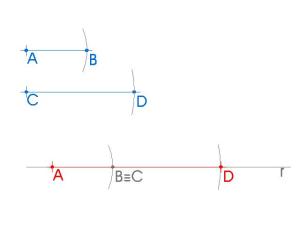
- Draw a line (r).
- Draw a point A on it.
- Measure the given segment AB with your compass.
- Draw an arc from A with that measure, so you get B.
- Measure the given segment CD with your compass.
- Draw an arc from B with that measure, so you get D.
- The solution is the segment AD.
SUBTRACTION SEGMENTS
We use this exercise if we have two given segments and we want to draw a segment whose measure is the substraction of the measures of those two segments.

- Draw a line (r).
- Measure the longest segment with your compass, in our case is the segment CD.
- Draw a point C on r.
- Draw an arc from dot C with the previous measure (the segment CD), so you get D.
- Measure the smallest segment with your compass, in our case is the segment AB.
- Draw an arc from D with that measure, so you get B.
- The solution is the segment CB.
DIVIDE A SEGMENT IN PROPORTIONAL PARTS TO THE GIVEN SEGMENTS.

- Draw a segment and call it AB.
- Draw an oblique ray (r) to the segment from A.
- Now we are going to divide segment AB into proportional parts to the given segments CD, DE and EF. We know the measures of these segments.
- Take the measure of the given segment CD with your compass.
- Draw an arc from dot A with this measure and where this arc crosses the oblique ray we get a point.
- Take the measure of the given segment DE with your compass.
- Draw an arc from the point and where this arc crosses the ray we get another point.
- Take the measure of the given segment EF with your compass.
- Draw an arc from last point and where this arc crosses the ray we get another point.
- Now we need to join this last point with dot B.
- Using our set square draw parallel lines to that segment from the other points on the ray.
- Where these lines cross the segment AB we get the new segments C’D’, D’E’ and E’F’.
According to Thales’s theorem the segment C’D’ is proportional to segment CD and it will be the same with segment DE and D’E’ and EF with E’F’.




